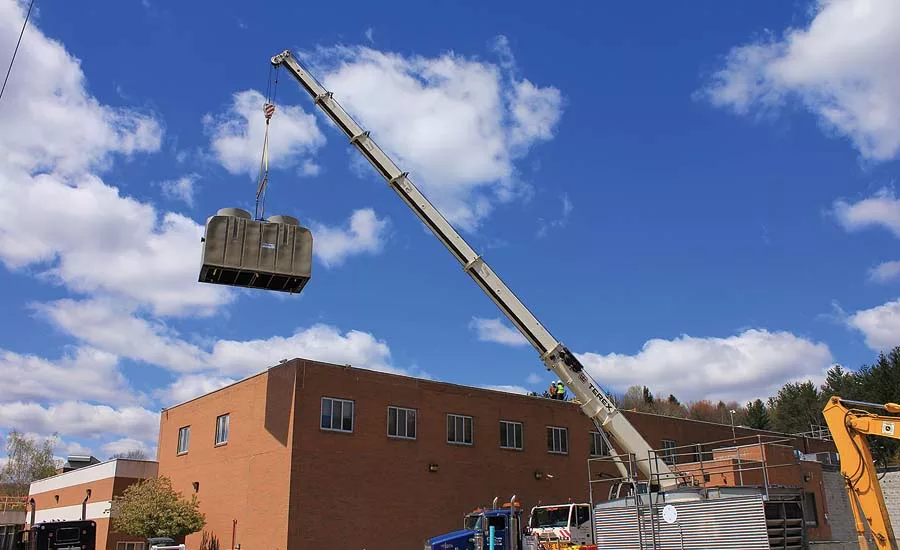How to properly size cooling towers
Cooling towers are a relatively inexpensive and reliable way of expelling heat from a number of industrial processes.

High-density polyethylene engineered (HDPE) cooling tower shells are virtually impermeable to corrosive elements, including water-treatment chemicals such as chlorine, as well as UV rays. Photo credit: Delta Cooling Towers
Cooling towers are a relatively inexpensive and reliable way of expelling heat from a number of industrial processes, including nuclear and thermal power plants, petroleum refineries, petrochemical plants, food processing plants, and HVAC systems.
As the worldwide market for these applications continues to grow, so does the need to address the question: How large should a cooling tower be to efficiently handle a specific application?
“There are a lot of different applications where you certainly don’t want an undersized cooling tower,” said John Flaherty, president of Delta Cooling Towers. Delta manufactures a broad line of high-density polyethylene engineered (HDPE) plastic tower models.
“For example, if an undersized cooling tower is not producing cold enough water to cool the condenser loop of an office building’s HVAC chiller, then the chiller could shut down. That would probably mean some expensive repairs plus a lot of angry tenants.”
On the industrial side, Flaherty advises that insufficient tower cooling capacity can cause breakdowns or even severe damage to costly process equipment, resulting in extensive losses in productivity. In fact, determining the minimum size for most any application is critical.
Cooling towers are known, generally, for their ability to expel waste heat from an industrial process or the condenser in a comfort cooling application. Wet cooling towers achieve this function through evaporating a small portion of the recirculating water, resulting in significant cooling of the returning water to the process.
Cooling tower sizing
For most wet cooling tower applications, optimum cooling tower size may be determined by a combination of four different metrics: Heat load, range, approach, and wet bulb temperature (WBT). In order to understand how these factors influence cooling tower size, it is first necessary to give the terms some context.
The wet bulb temperature of the air entering the cooling tower is an independent variable that is a fundamental factor in dictating the appropriate size of a cooling tower. It is both the theoretical limit to the exiting cooled water temperature and the only specific air parameter necessary in cooling tower selection. In sizing a cooling tower, the highest WBT expected temperature is used for very hot, humid climates.
The thermal performance of mechanical draft towers is barely affected by relative humidity or by the dry bulb temperature (true thermodynamic temperature) of the entering air. For mechanical draft towers, the amount of mass airflow (generated by fans) constitutes much of the hot-water-cooling capacity of the tower.
Dry bulb temperature and relative humidity do have a major effect on the performance of natural draft towers, or those without fans.
The difference between the WBT and the cooled water temperature is called the approach temperature, or simply, approach. Approach temperatures generally fall between 4° and 20°F. As the approach temperature drops, the required cooling tower size increases exponentially. However, many cooling tower manufacturers do not guarantee tower performance when approach temperature is less than 5°.
The difference between the tower’s hot water temperature (water leaving the hot machinery) and the cold water temperature is called the range. Along with WBT and approach, range also affects cooling tower size requirements. The heat load varies directly with range and flow rate (gallons per minute).
“When three of four sizing factors are held constant, the requirement for cooling tower size varies directly with heat load, but inversely with range, approach, and wet bulb temperature,” Flaherty explained. “So, there can be several design decisions to make that will impact the ultimate size of the required cooling tower.”
Efficiency matters
Flaherty adds that maintaining cooling tower efficiency is important to most applications. In many cooling towers, particularly the wet metal-clad models, cooling efficiency is compromised when necessary aggressive chemical treatments are limited due to the risk of damage to metal surfaces. Also, chemicals such as those used to rid water of biological growth can cause fouling buildup inside the tower, which reduces cooling efficiency.
“This is one of the reasons why cooling towers composed of HDPE plastic are becoming more popular,” Flaherty said. “With the HDPE towers, you can treat the water more aggressively and don’t have to worry about corrosion problems at the tower.”
Another efficiency-related advantage of HDPE cooling towers is they are impervious to corrosion. The corrosives present in salt water air or the caustic atmosphere of many industrial sites continuously attack metal-clad towers, making them less efficient and prone to maintenance and unscheduled shutdowns. Because HDPE towers are unaffected by corrosives, they require little maintenance and provide a much longer service life.
Cooling tower efficiency can also be affected by tower footprint.
“Some companies choose a tower with a smaller footprint to conserve on space,” Flaherty notes. “But that may require using more power to drive the tower, and energy savings is high on a lot of companies’ priorities. So, in those cases, a cooling tower with a bigger footprint may consume much less energy and would be the more efficient choice.”
Flaherty adds that for most industrial and commercial applications, it is highly beneficial to consult with an experienced cooling tower engineer before finalizing plans to purchase a tower for a facility. Delta Cooling Towers provides assistance in determining cooling tower size in a range of different tower designs at www.deltacooling.com/resources/selecting-sizing.
This article was originally titled “Sizing up cooling towers” in the December 2016 print edition of Plumbing & Mechanical.
Looking for a reprint of this article?
From high-res PDFs to custom plaques, order your copy today!






